Black Metal, Death Metal, Grindcore, Thrash and Heavy Metal Reviews from the net's original Heavy Metal site
Metal Genres
Death Metal Black Metal Grindcore Thrash Speed Metal Heavy MetalMetal Music
Heavy Metal F.A.Q. Interviews Philosophy Metal Concerts Heavy Metal CDs Heavy Metal MP3sMetal Media
Articles Heavy Metal Zines Heavy Metal Video Heavy Metal Books Metal LinksMetal Community
About Contact Metal Forum Letters Mailing ListClassical Music for Metal Fans
The Two Musical Styles Are More Similar Than Different
November 16, 2008
Underground metal -- the more artistic and less crowd-pandering arm of the heavy metal genre -- headed downwards in quality simultaneously heading upward in quantity, starting in about 1994. As the old bands got sick of their day jobs and sold out in failing bids to become "professional" musicians like crowd-pandering heavy metal, and the new bands started imitating the effects of older metal without knowing the causes, underground death metal and black metal fans began casting out for something new.
Our choices are bleak. We can try jazz, but it's not only pompous, repetitive and random, but also the exact contrary spirit to what metal espouses: a charging ahead and saying YES to life by accepting the intolerant and violent aspects of nature as necessary for its beauty. Jazz is socialization music. So is rock, pop, etc. What's left? We could listen to neofolk, but after about three albums it becomes clear that neofolk is a sham, namely bad rock music that sells because it is controversial and played acoustically sometimes like folk music. Then there's electronica, which has a few acts but is mostly more party music. Popular music does not offer another genre with the power and sincerity of metal, so instead you get "soul" which means blind compassion and encourages, rather than discourages, submission to conformity.
There is an option but unfortunately for modern listeners, it does not conform to the production values of rock, so you can't throw it on and have it aggressively grab your head the way loud-mastered, constant syncopated drumming and "soulful" human wailing will. It requires you to clear your desk, empty your mind and listen with your whole attention, and as a result it's less convenient than the junk they'll sell you at the record store. It's not as cheap to produce or promote either, which is why that record store is there -- listening to classical is not just bucking a trend, it's bucking an industry based around trends, and the same industry that afflicts metal and turns good bands into crowd-pandering drek.
For the metalhead looking to get into classical music there is almost no recognition of this effect. The classical fans have no idea how to communicate with metalheads (and generally don't understand or like metal, conflating Guns and Roses with Demilich, Atheist and Gorguts in the most oblivious way possible) and the classical industry has been sidelined for so long that it has no idea how to explain the beauty of classical or give modern listeners a chance. It operates like a cult, assuming that those who are in the cult belong there and everyone else is crazy -- not a horrible assumption, you'll find after six months of listening to classical, given the wide gulf of quality and brainpower between classical and mainstream music.
To address this problem, we list here some good introductory pieces and recordings for metalheads. Unlike popular music, classical music is written by a composer, shaped by a conductor and performed by an orchestra -- and that does not even take into account different recording times, technologies and locations. So there's another four layers on top of the mind-numbingly-simple "Band Name - Album Name" that we're accustomed to, thanks to metal's heritage in rock. These pieces are here because they capture the spirit of metal -- a Romanticist transcendental idealism -- in a way that eases you into the transition.
-
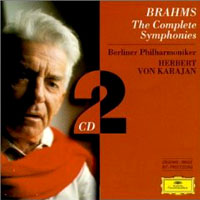 Brahms, Johannes - The Four Symphonies
Brahms, Johannes - The Four Symphonies
Pure Romanticism, which is the most beautiful classical genre but also its most easily misled into human emotional confusion. Flowing, diving, surging passages which storm through tyrannical opposition to reach some of the most Zen states ever put to music.
Four Symphonies by Herbert von Karajan/Berliner Philharmonik Orchestra
-
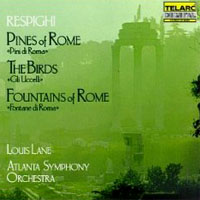 Respighi, Ottorino - Pines, Birds, Fountains of Rome
Respighi, Ottorino - Pines, Birds, Fountains of Rome
Italian music is normally inconsequential. This has an ancient feeling, a sense of weight that can only be borne out in an urge to reconquest the present with the past.
Pines, Birds, Fountains of Rome by Louis Lane/Atlanta Symphony Orchestra
-
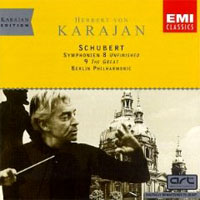 Schubert, Franz - Symphonies 8 & 9
Schubert, Franz - Symphonies 8 & 9
A sense of power emerging from darkness, and a clarity coming from looking into the halls of eternity, as translated by the facile hand of a composer who wrote many great pieces before dying young.
Symphonies 8 & 9 by Herbert von Karajan/Berliner Philharmonik Orchestra
-
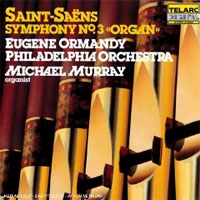 Saint-Saens, Camille - Symphony 3
Saint-Saens, Camille - Symphony 3
Like DeBussy, but with a much wider range, this modernist Romantic rediscovers all that is worth living in the most warlike and bleak of circumstances.
Symphony No. 3 by Eugene Ormandy/Philadelphia Orchestra
-
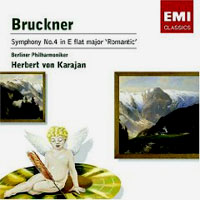 Bruckner, Anton - Symphony 4
Bruckner, Anton - Symphony 4
Writing symphonic music in the spirit of Wagner, Bruckner makes colossal caverns of sound which evolve to a sense of great spiritual contemplation, the first "heaviness" on record.
Romantic Symphony by Herbert von Karajan/Berliner Philharmonik Orchestra
-
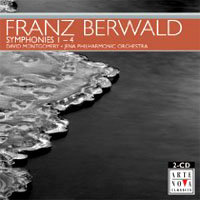 Berwald, Franz - Symphony 2
Berwald, Franz - Symphony 2
The passion of Romantic poetry breathes through this light and airy work which turns stormy when it, through a ring composition of motives, seizes a clear statement of theme from its underlying tempest of beauty.
Symphony No. 2 by David Montgomery/Jena Philharmonic
-
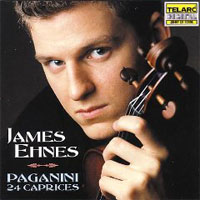 Paganini, Niccolo - 24 Caprices
Paganini, Niccolo - 24 Caprices
Perhaps the original Hessian, this long-haired virtuoso wore white face paint, had a rumored deal with the devil, and made short often violent pieces that made people question their lives and their churches.
24 Caprices by James Ehnes
-
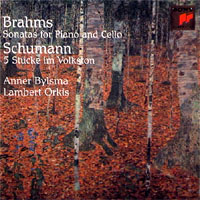 Anner Bylsma and Lambert Orkis - Sonatas by Brahms and Schumann
Anner Bylsma and Lambert Orkis - Sonatas by Brahms and Schumann
We list these by performer because this informal and sprightly interpretation is all their own. Played on period instruments, it captures the beauty and humor of these shorter pieces with the casual knowledge of old friends.
Brahms: Sonatas for Piano and Cello; Schumann: 5 Stücke im Volkston
Some conductors do an excellent job of certain styles, and so get picked more than others. Herbert von Karajan, in particular, is the original master of the Faustian style of conducting Northern European classical music. Certain performers like Orkis and Bylsma are also preferred for their ability to interpret certain ideas that -- like genres have ideas in common and as a result, sounds in common -- composers explored as part of their collective membership in certain time periods or recurring ideas, like the Faustian, the Romantic and the reverent/sublime outlook, all of which are shared between metal and classical.
These similarities in composition explain why metal and classical have a lot in common -- and this is why the correct interpretors are needed. Rock is harmonic-rhythmic, metal is phrasal-narrative. When making rock music, you pick a rhythm, and then use a standard song form or variation to fit it into a scale, which in turn determines harmony. Rock riffs are not as active or as shaped as metal riffs, because generally they are variations within a scale whose goal is to return to the chord being played; they are based around open chords and lead rhythm playing of the scale. Metal is phrasal, meaning that its riffs take the form of phrases made of power chords, and narrative, which means that metal song structure is determined by content of each song more than by a standard form -- that's the infamous "riff salad" rock musicians bemoan in metal.
Classical music also uses narrative composition. While imbeciles will focus on its fixed forms -- sonata, fugue, aria -- the more important idea here is that the song follows the poetic content being expressed. This mirrors the epic poetry of ancient European and Indian civilizations, where it was understood that each adventure had stages of ritual, much like we have stages in acceptance of death or change. As a result, there was a need for an overture, a reconsideration, some changes and a recapitulation and synthesis of themes, and these got formalized in the song structures that today imbeciles regard as iron laws. The narrative style however is the common thread in classical music from its beginning to the present.
In rock music, you write to fit the scale to the rhythm, and then melody is added to accentuate that. This is easier work because all of the real variables are defined by the form. Similarly, in jazz, the form is fixed and within it the player riffs off harmony and rhythm, and inserts fragments of melody to that end -- this is why most jazz artists make thousands of recordings of a song, and only one or two are considered "the real deal" by collectors: without the artist making it happen, cerebrally, the pieces fit together by random convenience. Classical works by the opposite principle, which is creating or adapting a general form to the poetic needs of a piece -- expressing the change in both listener and "actor" within the story or feeling being related -- and then designing a combination of rhythm, melody, theme, motif and form to express it well.
Metal is similar, although less schooled in this regard, because it seeks to express a similar worldview -- underlying philosophical assumptions about life -- to that of classical. Metal is reverent for the sublime; it sees the power and the horror of nature as necessary for its perpetuation, and is like nature intolerant of the oblivious and unrealistic because they create a parasitic slowdown of the exciting experiences in life. It derives much of its thematic development from the pace of horror movies, in which a few "awakened" people realize that they face a supernatural -- or invisible pattern underlying all reality -- foe against which technology and their oblivious, unrealistic social partners are useless. Finally, metal like classical expresses the Faustian spirit, or a sense of struggling for the rare and inconvenient beauty life offers, and fighting back those who submit to static obedience or dogma; this sense of purity through struggle is called vir, or the virtuous warlike acts of ancient man. These themes repeat throughout classical music, like metal, and while there are exceptions, it's more than a coincidence that the best among metal and classical use these themes repeatedly.
If you find yourself enjoying the above, we recommend you move on to other classical music that expresses these ideas, and bypass the trendier "new music" and quirky classical that your friends, in an attempt to impress you with how knowledgeable or non-normal they are, will tell you are important. Our attitude is different: build outward from the greats and later get into the novelties like "new music" or Eric Satie, Charles Ives or John Cage, if you decide at that point that you want to explore postmodernism, which is deconstruction of all that metal and classical music desire. In any case, we hope you enjoy the music and can turn on some friends to this treasure of musical beauty that hides in plain sight amongst us.